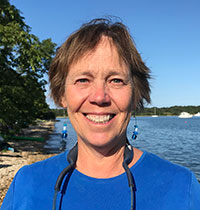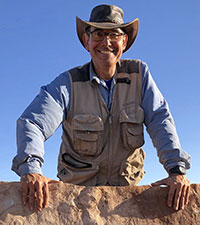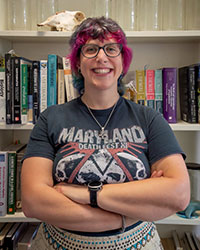 Tory L. Botha. School of Biological Sciences, Faculty of Sciences, Engineering and Technology, University of Adelaide, North Terrace, Adelaide, South Australia, Australia. tory.botha@adelaide.edu.au
Tory L. Botha. School of Biological Sciences, Faculty of Sciences, Engineering and Technology, University of Adelaide, North Terrace, Adelaide, South Australia, Australia. tory.botha@adelaide.edu.au
https://orcid.org/0000-0002-2519-9365
Tory Botha has just completed her PhD at the University of Adelaide examining the palaeobiology and palaeoecology of radial taxa from the Ediacara Biota of the Flinders Ranges, South Australia. She uses morphometrics (the statistical analysis of shape) to determine patterns in symmetry and asymmetry, with the focus on untangling morphology and growth from the effects of preservation.
![]()
 Mary L. Droser. Department of Earth and Planetary Sciences, University of California at Riverside, Riverside, California, USA. droser@ucr.edu
Mary L. Droser. Department of Earth and Planetary Sciences, University of California at Riverside, Riverside, California, USA. droser@ucr.edu
https://orcid.org/0000-0001-71
Mary Droser is a Distinguished Professor at the University of California, Riverside. She works in the area of evolutionary paleoecology, examining large-scale interactions between life and environments. In the last 20 years, with Australian colleagues, she has focused on the Ediacaran of South Australia publishing over 50 journal articles on this extraordinary fossil record. Topics include the earliest sexual reproduction, descriptions of new body plans, the advent of mobility and so on. She received the National Academy of Sciences Walcott Medal and the 2024 Paleontological Society Medal for her work on the Ediacara Biota.
![]()
 Diego C. García-Bellido. School of Biological Sciences, Faculty of Sciences, Engineering and Technology, University of Adelaide, North Terrace, Adelaide, South Australia, Australia and Earth Sciences Section, South Australian Museum, North Terrace, Adelaide, South Australia, Australia. diego.garcia-bellido@adelaide.edu.au
Diego C. García-Bellido. School of Biological Sciences, Faculty of Sciences, Engineering and Technology, University of Adelaide, North Terrace, Adelaide, South Australia, Australia and Earth Sciences Section, South Australian Museum, North Terrace, Adelaide, South Australia, Australia. diego.garcia-bellido@adelaide.edu.au
https://orcid.org/0000-0003-19
Diego studies the early evolution of complex life during in the Ediacaran and Cambrian, half a billion years ago. He excavated at the famous Burgess Shale Cambrian fossil locality in Canada between 1995 and 2000 and worked at the Royal Ontario Museum in Toronto for several years. In 2007 he joined the Australian research team excavating the Cambrian Emu Bay Shale in Kangaroo Island and for the last decade he has also been studying the Ediacara Biota from the Flinders Ranges, with the goal of finding the links of these iconic organisms with the Cambrian faunas. Diego has carried out palaeontological fieldwork from Morocco to the US, from China to Argentina, and even been privileged to visit Antarctica.
![]()
 Emma Sherratt. School of Biological Sciences, Faculty of Sciences, Engineering and Technology, University of Adelaide, North Terrace, Adelaide, South Australia, Australia. emma.sherratt@adelaide.edu.au
Emma Sherratt. School of Biological Sciences, Faculty of Sciences, Engineering and Technology, University of Adelaide, North Terrace, Adelaide, South Australia, Australia. emma.sherratt@adelaide.edu.au
https://orcid.org/0000-0003-2164-7877
Emma Sherratt is an evolutionary biologist with a focus on understanding trait evolution by the statistical analysis of shape (morphometrics). She studied Zoology at University of Manchester (UK) and completed a PhD on the evolution of caecilian amphibians at the Natural History Museum (London, UK) and University of Manchester. Reptiles and amphibians are her passion, but she has researched a diverse array of animals including snakes, rabbits and mice, caecilians, Anolis lizards, bivalved scallops, and frogs (and their tadpoles). She is currently a Senior Lecturer and lead of the Quantitative Morphology Group at University of Adelaide (Australia).

